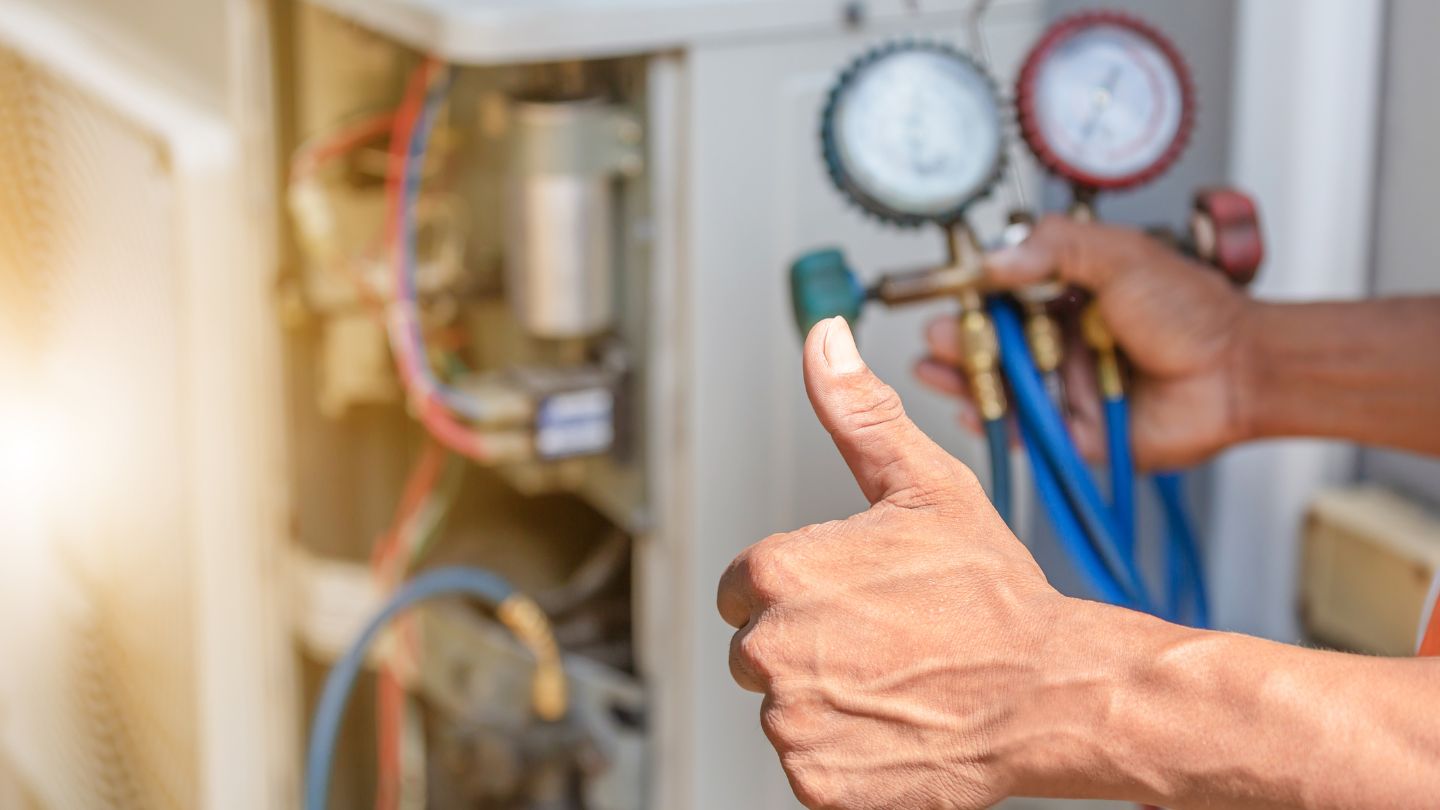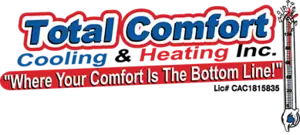Air Conditioning Tips to Keep Your AC Unit Running All Summer Long
How can you stay cool and save on energy bills this summer? Our air conditioning tips for summer provide practical advice on using your AC efficiently. This blog explores how to set your thermostat, maintain your unit, and improve home insulation for optimal cooling.
Key Takeaways
- Set your thermostat to 78°F for optimal comfort and energy savings and use a programmable thermostat for further efficiency.
- Enhance cooling with ceiling fans set to counterclockwise rotation and improve insulation by sealing leaks around windows and doors.
- Consider upgrading to an Energy Star certified air conditioning unit for significant savings and reduced environmental impact.
Optimize Your Thermostat Settings
Properly managing your thermostat can significantly impact both your level of comfort and the cost of your energy bills. The U.S. Department of Energy advocates for maintaining an indoor temperature around 78°F during summer months to balance comfort with energy efficiency and prevent unnecessary energy consumption while keeping cool. By increasing the thermostat setting a few degrees when you’re not at home, you’ll be able to achieve noticeable energy savings without sacrificing personal comfort upon returning.
Where you install your thermostat is crucial in achieving effective cooling without excess costs. Placing it too close to appliances that generate heat or areas receiving direct sunlight might trigger frequent and needless cycling, thus diminishing its cooling effectiveness. To optimize performance, position the thermostat away from such sources of heat and out of direct exposure to sunlight.
Resist reducing the temperature on your AC unit below what’s typically comfortable in hopes that this will expedite cooling. This does nothing but escalate energy expenditures needlessly.
The Best Temperature for Comfort and Savings
During the summer months, maintaining your thermostat at 78°F can provide a harmonious mix of comfort and energy efficiency. The U.S. Department of Energy advises that this setting helps in reducing the strain on your cooling system when outside temperatures soar above 100 degrees.
If you adjust your thermostat higher than 72°F, you stand to benefit from reduced cooling expenses. It’s estimated that for each degree you raise the temperature setting, about a 3% savings on cooling costs can be achieved—thus positioning it at 78°F could notably diminish your energy bill without sacrificing comfort levels.
While preferences for comfortable indoor temperatures might differ among individuals and vary according to regional climate conditions, aiming roughly for a moderate temperature around 75 degrees is often seen as an acceptable compromise to balance both personal comfort and efficient energy use.
Using a Programmable Thermostat
Employing a programmable thermostat can streamline the management of your air conditioning, ensuring the indoor temperature is always ideal and energy consumption is efficient. It accomplishes this by cooling your space at pre-set intervals so that it remains comfortable when occupied and minimizes energy usage during times you are away—this approach can lead to considerable monetary savings while still preserving a pleasant home environment.
Adjusting your thermostat to elevate the ambient temperature between 7 and 10 degrees while absent from home could result in up to a 10% reduction on your energy bill, thereby markedly decreasing how much energy you use.
When considering an upgrade for your HVAC system, investing in a programmable thermostat should be regarded as beneficial not only for maintaining comfort but also enhancing system efficiency.
Utilize Ceiling Fans Effectively

Utilizing ceiling fans can significantly enhance the circulation of air within your residence, giving off a sensation of coolness even amidst elevated temperatures. When combined with your air conditioning system, these fans enable you to depend less on the AC unit by augmenting energy efficiency.
By better dispersing the already cooled (conditioned) air throughout your home, ceiling fans contribute to maintaining a more agreeable and cooler environment.
Proper Fan Direction
In the summer months, adjust your ceiling fans to spin in a counterclockwise direction. This motion forces cool air downwards and generates a breeze that can make the room seem cooler by up to four degrees without the need for substantial changes to your thermostat’s cooling setting.
Combining Fans with AC
Utilizing ceiling fans in conjunction with your air conditioning system improves comfort and permits you to increase the temperature setting on your air conditioner, thereby yielding considerable energy savings. It is possible to adjust your thermostat approximately 4°F higher while still maintaining a comfortable environment.
Employing this strategy aids in more effective distribution of the conditioned air across your residence, which reduces the workload on your AC system and results in energy conservation.
Enhance Home Insulation and Ventilation
Enhancing insulation effectively reduces the transfer of heat, aiding in maintaining your home at a cooler temperature and conserving energy. By sealing off any gaps near windows and doors, you prevent hot air infiltration and retain cool conditioned air within the premises. This not only boosts the efficiency of your energy use, but also eases the burden on your air conditioning system by reducing its operational demands.
Ensuring adequate ventilation is crucial for sustaining a comfortable atmosphere inside your home while averting an increase in humidity levels.
Sealing Leaks and Cracks
It is essential to seal any leaks and fissures in order to keep indoor temperatures lower and increase comfort levels. By implementing weatherstripping on doors and using a sealant for the spaces around windows, you can hinder drafts and stop air from escaping. For more substantial gaps surrounding windows and baseboards, foam sealant proves effective at elevating air-tightness which aids in lowering energy expenses.
Addressing air leakages markedly augments the coziness of your home by doing away with drafts along with areas prone to cold air intrusion.
Effective Window Coverings
Effective window coverings reduce heat entry and maintain a cooler indoor environment. Light-colored blinds or curtains reflect sunlight, reducing heat entry. Cellular shades and insulating blinds trap air and provide insulation, keeping your home cool in the summer.
Blackout roller shades or solar shades also minimize heat entry, enhance indoor comfort, and support energy efficiency.
Regular AC Maintenance

Ensuring your AC unit receives consistent maintenance will allow it to operate smoothly and effectively all summer, prolonging its life and averting expensive repair jobs.
By maintaining your air conditioning system in excellent working order, you can guarantee that it cools the air efficiently, lowers energy use, and keeps the indoor atmosphere pleasantly cool.
Annual Service Check
To preserve the efficiency and extend the life of your air conditioning unit, it’s crucial to have it serviced annually. Such regular check-ups can identify potential problems promptly, averting expensive fixes and guaranteeing uninterrupted performance during summer.
Selecting a qualified HVAC contractor should involve verifying that they have appropriate licensing and insurance. Assess customer reviews, weigh up their services against pricing, and consider any extra advice provided.
Upgrade to an Energy-Efficient AC Unit
If your air conditioning system frequently breaks down or incurs high running costs, it might be time to upgrade. Installing an energy-efficient AC unit can lead to significant savings and increase property value. Energy Star certified systems offer high energy efficiency and substantial savings on utility bills. When selecting a new air conditioner, consider your budget, specific needs, and the unit type suitable for your home.
The right air conditioning unit depends on your home’s size, layout, and local climate. Carrier offers various systems, including central AC units and ductless options, catering to different setups.
SEER and EER ratings are efficiency standards that help compare the energy performance of HVAC systems, making it easier to choose the most energy-efficient option for your needs, including considerations of seasonal energy efficiency ratio.
Benefits of Energy Star Certified Units
Air conditioners that have earned the Energy Star certification meet stringent energy efficiency criteria established by the Environmental Protection Agency (EPA). Such units are designed to deliver notable energy savings, allowing homeowners to cut down on their utility bills. Opting for an air conditioner with the Energy Star label guarantees a cooling system that is both more energy efficient and better for the environment.
To provide energy savings, these air conditioning systems help reduce one’s carbon footprint while improving comfort inside homes. The decision to invest in an Energy Star certified air conditioning unit translates into sustained financial benefits and contributes towards creating an eco-friendlier household setting.
Financing Options for New Units
Homeowners can take advantage of financing arrangements for HVAC systems, which provide the convenience of affordable monthly installments. This facilitates the acquisition of a modern, energy-efficient air conditioning unit without necessitating a hefty initial outlay.
There are also opportunities to alleviate monetary constraints through government rebates and federal tax incentives when purchasing HVAC equipment, thereby enhancing your ability to save money on such investments.
Smart Landscaping for Cooler Homes
By carefully planning your landscape, you can greatly enhance the natural cooling of your home, thus improving energy efficiency. The use of trees, bushes, and reflective surfaces in the design of your outdoor space can lead to a reduction in indoor temperatures by providing shade and insulation, which diminishes the need for air conditioning.
Such methods boost energy savings while also creating an environment within your home that is cooler and more comfortable.
Planting Shade Trees
Positioning shade trees around your residence can lead to considerable cooling advantages. During the summer, deciduous trees grant ample shade but permit sunlight in winter to heat your dwelling. Their expansive canopies hinder direct sun rays from raising indoor temperatures, thus diminishing the reliance on air conditioning for cooling.
Such a method of natural temperature regulation results in notable energy conservation and enhances the comfort of your home environment.
Using Heat-Reflective Materials
Utilizing materials that reflect heat on the exterior surfaces of your home can drastically reduce indoor temperatures by deflecting solar heat away. This approach reduces the amount of heat absorbed, which helps maintain a cooler environment within your home during summer.
Applying these reflective materials to roofs and outer walls diminishes the warmth inside, consequently lessening reliance on air conditioning. This contributes to an improvement in energy efficiency throughout periods when temperatures are high.
Efficient Use of Household Appliances
By utilizing household appliances in a more efficient manner, you can greatly decrease the amount of heat they produce and alleviate some of the burden on your air conditioning system. Implementing minor adjustments like employing ceiling fans to diminish cooling demands or limiting dehumidifier use to essential areas with minimal settings can improve comfort while also reducing utility expenses.
Conscious management of appliance operation contributes to preserving a cooler living environment and conserving energy.
Cooking and Laundry Tips
Carrying out cooking and laundry chores either in the early hours of the morning or late at night can diminish the accumulation of heat during summer within your residence. By not engaging in these tasks when temperatures peak, you prevent additional generation of heat, thereby assisting in maintaining a cool home.
Such an easy modification aids in preserving a typically comfortable indoor climate while simultaneously lessening the workload on your air conditioning system.
Energy-Efficient Lighting
Transitioning to LED bulbs, which are energy-efficient forms of lighting, substantially reduces the production of heat and cuts down on energy use. Because LEDs emit less heat than standard incandescent bulbs do, they assist in keeping the indoor temperature cooler while also lowering utility expenses.
To promote Savings in both heat and energy, dimming lights or switching them off when they aren’t needed helps conserve energy efficiently.
Stay Cool and Comfortable All Summer
Keeping your air conditioning system in top shape throughout the summer requires a mix of smart habits and proactive maintenance. By optimizing your thermostat settings, using ceiling fans effectively, improving insulation, and performing regular upkeep, you can enjoy a cool, energy-efficient home while reducing your environmental impact.
At Total Comfort Cooling & Heating, we specialize in helping you achieve these goals with expert services like AC repair in North Port. Whether it’s routine maintenance, system upgrades, or an energy-efficient upgrade, we’re here to deliver superior solutions tailored to your needs. Trust us to keep your home comfortable while maximizing the performance of your air conditioning system!
Frequently Asked Questions
Why is it advisable to service an air conditioning unit annually in North Port?
It is crucial to perform annual service on your air conditioning system in North Port to boost its efficiency, extend its operational life, and catch potential problems before they escalate into expensive repairs.
Consistent upkeep guarantees peak functioning and dependability for the duration of the season.
What should you check when choosing an HVAC contractor?
When choosing an HVAC contractor, it’s essential to verify their licensing and insurance, assess customer reviews, and compare their services and prices.
This will ensure you select a reliable and qualified professional for your needs.
What services does Total Comfort Cooling & Heating offer in North Port?
Total Comfort Cooling & Heating provides exceptional heating and air conditioning services for residential and commercial properties in North Port.
Their expertise ensures comfort and reliability for all your climate control needs.
How often should HVAC maintenance be scheduled in North Port?
HVAC maintenance should be scheduled twice a year, ideally in the spring and fall, to ensure optimal performance and longevity of your system.
Regular maintenance helps prevent costly repairs and improves energy efficiency.
READY FOR YOUR NEXT HEATING OR COOLING PROJECT?
Contact us to get a quote and see why our customer service is recognized as the best in the industry.







 Special Offer: 12 Months - No Interest, No Payments!
Special Offer: 12 Months - No Interest, No Payments!